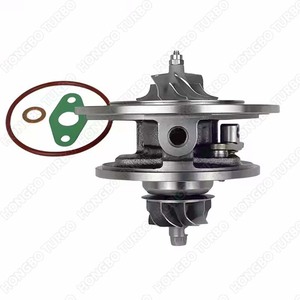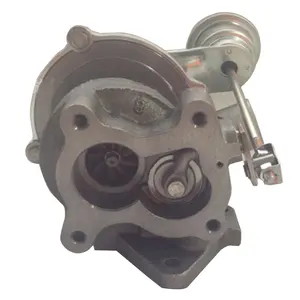(2325 products available)




















































































































































































A turbocharger, commonly known as a turbo, is a forced induction device that increases the power output of an internal combustion engine. It comprises a turbine and a compressor that are housed together in one unit. The turbo uses the engine's exhaust flow to spin an entry wheel, which in turn draws in air and pushes it into the engine's intake manifold. This results in a large amount of air being forced into the engine, which leads to boosted power and performance. There are several types of turbochargers available, including:
Single Turbocharger
Single turbochargers are the most common type of turbo and are mostly found in mainstream vehicles. The size of the turbo can vary depending on the vehicle's engine size. However, they are designed to strike a balance between performance and lag. Car enthusiasts looking for more power from their engines may opt for single turbos as they can be added to an existing engine.
Variable Geometry Turbocharger (VGT)
VGTs are specifically designed for diesel engines. They help to improve the overall performance and fuel efficiency of the vehicle. Unlike the other types of turbochargers that come with fixed blades, VGTs have movable blades that can be adjusted depending on the engine's speed. This allows the turbo to create a boost at any RPM, eliminating lag and ensuring a more responsive driving experience.
Dual Turbochargers
Some high-performance vehicles come fitted with dual turbochargers. These cars either have two smaller turbos or a combination of one VGT and a single turbo. The dual turbo setup is designed to maximize performance and power output from the engine, making it suitable for racing and other high-performance applications.
Electric Turbocharger
Due to advancements in technology, electric turbochargers have been developed. These turbos are still in the early stages of use and are mostly found in concept cars. The electric turbo uses electricity from the battery to spin the compressor wheels. By using electrical power, the turbo can eliminate lag completely and provide instant boost and acceleration.
Airflow and Size
The size of a Renault turbocharger is determined by the rotor diameter and housing dimensions. The rotor diameter can range from 40 to 100 mm or more, while the housing dimensions are usually expressed in A/R ratios (area-to-radius length ratio) that range from 0.1 to 1.5 or more. The A/R ratio affects the turbo's responsiveness and power delivery.
Pressure Ratio
Turbochargers are categorized based on their pressure ratio, which indicates how much they increase air pressure entering the engine. The pressure ratio varies between 1.5 and 4.0 or more, depending on the engine's performance requirements.
Materials
Various materials are used to construct turbochargers, each with distinct qualities. Common materials include cast iron (for turbine housings), stainless steel (for exhaust components), and inconel (for turbine blades). The choice of material affects the turbocharger's durability and heat resistance.
Cooling
Some Renault turbochargers have cooling systems to lower the temperature of the compressed air before it enters the engine. This cooling boosts the air's density, resulting in more oxygen and power. The cooling system can be either water-cooled or oil-cooled, with corresponding specifications for flow rates and temperature differentials.
Bearing Type
The type of bearings used in a turbocharger affects its reliability and maintenance requirements. Common bearing types include journal bearings and ball bearings. Journal bearings are more widely used due to their lower cost, while ball bearings offer better responsiveness and durability.
Wastegate Type
Wastegates control the exhaust flow through the turbine and regulate boost pressure. Turbochargers may have internal or external wastegates, each with unique specifications for spring rates and actuator sizes. The choice of wastegate type affects the turbo's control and performance consistency.
Maintaining the Renault turbocharger is essential for increasing its life span and performance. Here are some general tips for maintaining a turbocharger:
Oil Change
Changing the oil regularly is one of the simplest and most effective ways to maintain the Renault turbo. The oil keeps the turbocharged lubricated and reduces friction, preventing damage. Follow the manufacturer's recommended oil change schedule and use high-quality oil.
Cool Down
Allowing the turbocharged cool before turning off the engine is essential for maintaining the turbocharged. The turbo uses a lot of heat from the exhaust gases to spin a turbine and create boost. If the engine is turned off right away, the sudden stop can cause the turbo to heat up quickly, leading to premature wear or damage. Take a moment to idle the engine before shutting it off, especially after hard driving or towing.
Air Filter
The air filter is another important component when maintaining the turbo. A clean air filter ensures good airflow to the engine and helps the turbo work efficiently. Check the air filter regularly and replace it if dirty or clogged. Consider upgrading to a high-performance air filter for even better filtration and airflow.
Check Boost Pressure
Monitoring boost pressure can help spot any issues with the turbo early on. Use a boost gauge to see if the pressure matches what the manufacturer says. Too low or too high boost pressure can indicate problems with the wastegate, actuator, or other turbo parts. If you notice any changes in boost pressure, have a mechanic check the turbo for repairs.
Inspect Wastegate
The wastegate controls the exhaust flow through the turbine and regulates boost pressure. A faulty wastegate can cause boost spikes or drop-offs, affecting engine performance. Visually inspect the wastegate for any signs of damage, such as a stuck valve or leaks. Use a boost gauge to see if the wastegate is working properly. If you notice any issues with the wastegate, have it repaired or replaced as needed.
Fuel Quality
Using good quality fuel is essential for keeping the turbo in good shape. Low-quality fuel can lead to carbon buildup in the engine and on the turbo. Follow the manufacturer's recommendations for the right fuel type and octane level. Consider using fuel with turbo cleaners to help remove any deposits over time.
Check for Oil Leaks
Oil leaks can cause low oil levels and damage to the turbo. Periodically check the turbo and surrounding areas for any oil spots or drips. Also, check the oil lines and fittings for leaks. If you find any oil leaks, fix them right away to protect the turbo and other engine parts.
Follow Maintenance Schedule
Following the manufacturer's scheduled maintenance is vital to keeping the turbo and other engine parts in good condition. Stick to the recommended intervals for essential services like engine oil changes, air filter replacements, and timing belt changes. This will help avoid any potential issues with the turbo and ensure your engine runs smoothly.
When shopping for a turbocharger, consider the following factors:
Engine size and type
Buyers need to understand the engine's size and the kind of fuel it uses to work. This information will help in choosing the right turbo that fits well and works great with the engine.
Power goals
Think about how much power is wanted from the car. More power means a bigger turbo is needed. But if the goal is just a little extra power, then a smaller turbo will do.
Driving habits
The driving habits affect the turbocharger choice. For instance, buyers who drive mostly in the city and want quick power responses might prefer a turbo that spools up quickly, while those doing a lot of highway driving might want a turbo with a broader power band.
Budget
Setting a clear budget is vital as it helps narrow down options. However, it's crucial to consider the long-term benefits and savings of a turbocharger, alongside the initial cost.
Warranty and support
Buyers should choose turbochargers that provide adequate support and warranty. This ensures they get help if anything goes wrong and have peace of mind.
Quality and brand reputation
It's good to go for turbos from reputable brands known for quality. These companies may have a long-lasting product, so buyers won't have to replace the turbo often.
Renault turbochargers can be replaced easily by following the right steps. It is advisable to have a professional mechanic carry out the replacement. However, it is possible to replace the turbocharger on one's own as long as the right tools are available.
Before starting the process, ensure that all the necessary tools are available. These tools include a turbocharger socket set, torque wrench, oil drain pan, new oil drain gasket, new turbocharger, and new oil return gasket. Once the tools are available, follow the steps below:
1. Set Up
Switch off the engine and let it cool. Unplug the battery, then read the car manual and understand how the turbo works. Get the right tools for the job, then raise the car with a jack and put wheel stands for safety.
2. Remove the Old Turbo
Locate the turbo by following the exhaust from the engine. Disconnect the pipes linking the turbo to the engine and the exhaust. Drain the oil and take out the oil pipes. Unscrew the bolts holding the turbo and remove the turbo.
3. Prepare the New Turbo
Check the new turbo for any damage. Coat the oil ports with clean oil. Compare the old and new turbos to ensure they are the same.
4. Install the New Turbo
Put the new turbo in the right position and screw the bolts. Connect the oil pipes. Ensure that there are no oil leaks. Link the turbo to the engine and the exhaust. Double-check the connections.
5. Final Checks
Lower the car and reconnect the battery. Start the engine and listen for any unusual sounds. Check the oil levels and ensure everything is working.
Q1: How can one tell the Renault turbo is faulty?
A1: When the turbo is faulty, the car will not perform as it used to. The engine sound may change, and there may be a delay when accelerating. One can also see an error message on the dashboard. There may also be visible smoke coming from the exhaust pipe.
Q2: How long does a turbo last in a car?
A2: Generally, a turbo can last between 100,000 and 200,000 miles. However, its lifespan can be affected by driving habits, engine oil changes, and the quality of the oil used.
Q3: Can a turbo be replaced without changing the exhaust manifold?
A3: Yes, it is possible. The turbo can be replaced without changing the exhaust manifold. However, it is advisable to inspect the exhaust manifold for any damage or wear and replace it if necessary.
Q4: What is the difference between a turbo and an engine with more power?
A4: A turbo forces more air into the engine, allowing it to burn more fuel and produce more power. An engine with more power will not have a turbo fitted; instead, it will have a larger capacity to generate more power.